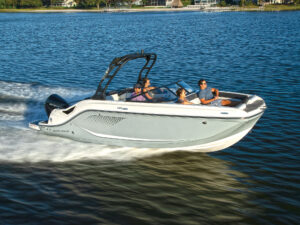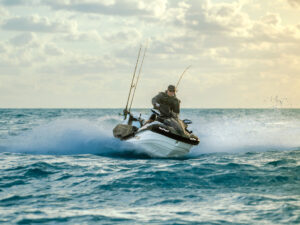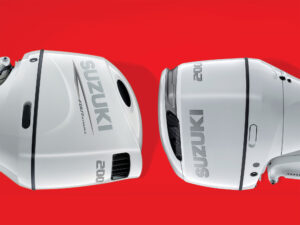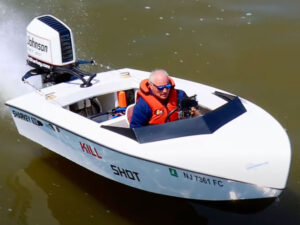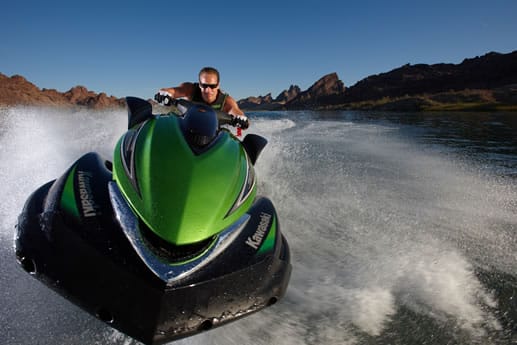
Brakes vs Off-Throttle Steering
Sea-Doo has generated plenty of buzz over the past couple years for its Intelligent Brake and Reverse (iBR) system. The Clif Notes version for those unfamiliar with the technology? iBR uses a modified reverse bucket, linked to a handlebar-mounted lever. Squeeze that lever and the craft’s computer brain interrupts thrust for a fraction of a second while the bucket deploys, then reapplies thrust, which is redirected forward via the bucket and provides stopping power. The pull comes from the stern and the computer limits the extent of the force, meaning the bow won’t dive and you won’t get launched over the handlebars. What you will do is stop up to 100′ shorter than if you were to simply let off the throttle alone. A rider can even feather the extent of the response, much like they would feather their car brakes when approaching a traffic light to avoid a jerky stop.
The technology is undeniably cool, but has opened up some debate amongst the brand’s competitors. They argue that iBR gives riders a false sense of security, and that an existing technology — off-throttle steering — actually provides superior collision avoidance.
THE WORLD’S MOST VERSATILE BOAT
Jet propulsion has many benefits, but one negative is that directional control stops when a rider releases the throttle, as no thrust is exiting the steering nozzle. Off-throttle steering uses sensors to recognize when a rider abruptly releases the throttle in conjunction with a full-lock turn in either direction, the typical sign of a panicked rider trying to avoid a collision. The system then increases thrust slightly, just enough to provide some movement in the direction the driver has attempted to steer. It’s a system that has been almost universally adopted by all manufacturers, as while it may not always avoid a collision, it can certainly lessen one.
One manufacturer released a YouTube video shortly after iBR was introduced, showing riders with iBR essentially mowing down a float they were trying to avoid. The same video showed a rider using off-throttle steering avoiding the float all together. Certainly the video made a very valid point — in some situations, off-throttle steering was the better alternative, as it provided an avoidance maneuver away from an object, whereas brakes essentially just slowed the rider in a straight line. But the video also used a short stopping distance that, in my opinion, unfairly tipped the scales. I made the point at the time that if we couldn’t expect a car to stop in such a short distance at the speeds in question, with all the friction afforded by brakes and tires on pavement, how could we expect a boat or PWC to do any better? The video in question has since been removed from YouTube.
The debate, however, lives on, and there’s a good chance you’ll hear it if you’re shopping between brands. My take? Both systems are good, and both have their faults as well. Off-throttle steering will in fact begin a collision-avoidance turn, but it’s response is relatively tame. At close quarters, it will likely lessen a collision, not avoid it. A skilled driver who stays on the throttle and cranks a turn may in fact fare the best in such a situation. Still, lessening an impact is a good thing, especially for beginners who will likely release the throttle when panicked. A glancing blow is certainly better than a head-on collision.
The system does, however, have its occasional problems. I’ve noted in previous reviews that sometimes the off-throttle “push” can come on unexpectedly. It happened to me once riding up on a group of stopped riders at a press event. As I steered toward them and released the throttle, the OTS system actually activated, surging me forward toward the group. I was at fault for coming in too fast and too close, certainly, but it’s something to watch out for.
With iBR, I like being able to rapidly slow if necessary, without trying to hook into a turn that could potentially put me into a worse situation. It’s intuitive in a panic, and it works relatively well. I also like the side benefits the system brings to the table. A Sea-Doo can start in a neutral mode rather than surge forward, and be shifted easily between reverse and forward without ever taking your eyes off the water or hands off the handlebars. It’s fantastic in tight quarters like a marina, restaurant dock or launch ramp.
But again, it’s not perfect. You still need some stopping distance, and that path is relatively straight. If something pops up quickly and unexpectedly at short distance, chances are you may hit it if relying on brakes alone. You will, however, be decelerating rapidly, rather than simply coasting in with no thrust.
Ultimately, the key is to simply spend time learning about your craft and its capabilities, and how best to use them. Brakes are appropriate for some situations, off-throttle steering for others, and a combination of the two, or neither, in yet others. That kind of awareness only comes with time in the saddle. While learning, take comfort in the fact that all the manufacturers have given you systems to keep you safer. But remember, the ultimate responsibility for avoiding a problem is up to you…
…and sometimes that takes good old-fashioned seamanship, responsibility, and an understanding of the rules of the road.
SUGGESTED READING

